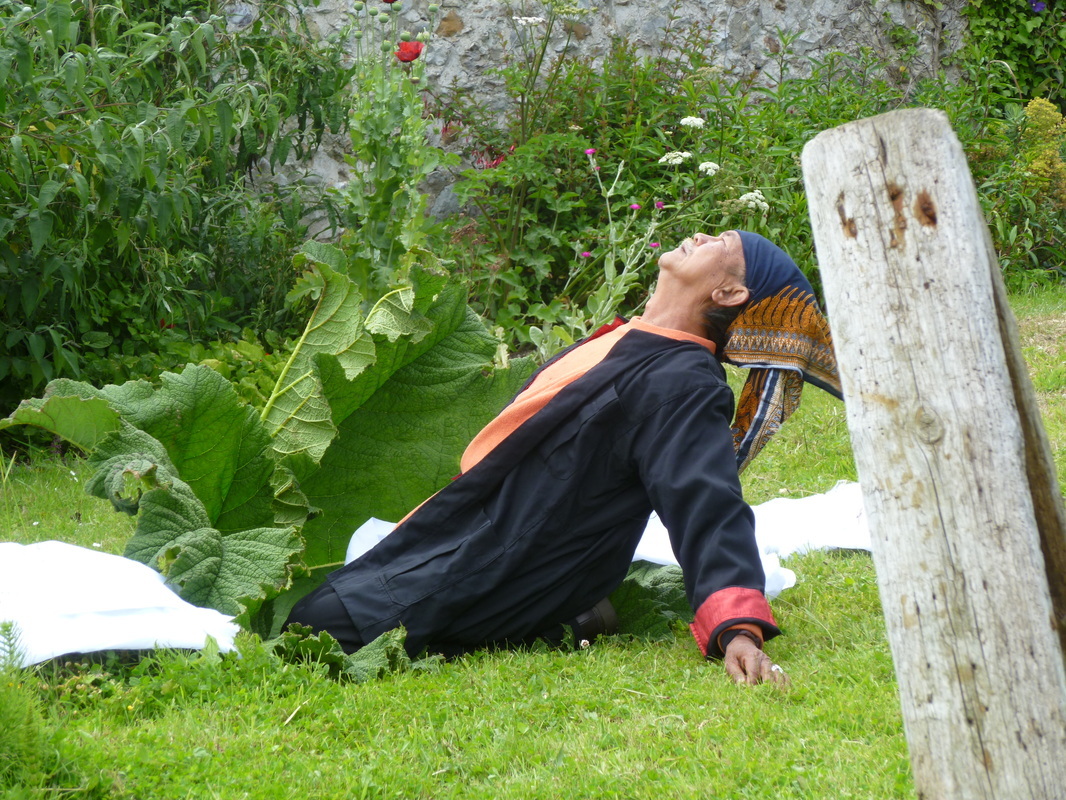Timeline 2 (1992-2015)
|
Amerta Movement Timeline: 1982 to 1988This timeline (prepared by Christina Stelzer) is an updated version of the one that appears in the 'Prapto Companion' section of Embodied Lives.
Joged Amerta is a movement practice developed by Suprapto Suryodarmo (Prapto), a Javanese movement artist and teacher. The following material describes some of the background to his teaching and movement workshops. (More details appear on Prapto's website.) The practice was developed at Padepokan Lemah Putih (Prapto’s interdisciplinary arts institution, located near Solo, Central Java) and also throughout the world where he has travelled and taught, in conversation with participants from many different countries. In 1970, Prapto started “to practise movement with the approach of exploring like a child…” He practised “in many conditions of time and space, in nature, temples exploring the qualities of freedom and limitation”. He perceived the world through movement rather than from stasis, or, as he initially described it, “from the Buddha walking, rather than from the Buddha sitting”. Alongside Buddhist practice and observing the movement of children, his practice was influenced by studying the elements and movement in nature, the practice of Sumarah (a traditional Javanese meditation practice of ‘letting go’ or surrender) and, through his parents’ influence, Javanese mysticism. In 1982 Prapto travelled to Europe for the first time with the Sardono Dance Company for the Milan Sladek International Pantomime Festival in Cologne, Germany. As a result of contacts made during that trip and during a subsequent trip to Switzerland in 1983, three Westerners travelled out to Solo to work with him for two months in March 1984. They were Christian Böhringer, Susanka Christmann, and Christina Stelzer. Timeline 1982 Prapto travels with the Sardono Dance Company to Cologne, Germany, for Milan Sladek’s International Pantomime Festival. Interested in contacts with people practicing T’ai Chi and/or dance, he meets Christina Stelzer. 1983 Prapto visits Geneva. Invited by Christine Rod and theater director Marcel Robert he offers practice to a gathering of people from the arts. Christina Stelzer and Christian Böhringer from Cologne join the gatherings. March 1984 Responding to Prapto’s invitation to come to Java, Christina Stelzer, Christian Böhringer and Susanka Christmann (who all studied with Anna Halprin, are teaching together, and set up seminars as the group ‚Im Puls’ ) begin a two-month process of enquiry and exploration with Prapto in Java. August 1984 The group ‚Im Puls’ invites Prapto to Germany, setting up a two-week program for movement friends and colleagoues. Participants of this program are: Andreas Leuze, Birgit Grundies, Hans Thalgott, Maren Repennning, Sabine Reif, Susanne Tümpel (all from Hamburg), Sigrid Gold (Cologne), Ingrid Hinderink (Munich) and Christine Rod (Genève). Christina, Christian and Susanka continue to practice with Prapto and at the same time begin to study his way of guiding. Prapto suggests they come back to Java for one year as a further step of learning and practising together. Summer 1985 First they organize several two-week programs for Prapto to run in Germany and accompany him throughout, continuing their studies together. About 50 people have the opportunity to work with him in Cologne, Hamburg and South Germany. Prapto also gives one seminar in Genève, set up by Christine Rod. October 1985 Christian, Christina and Susanka move to Java, joined by Christine Rod from Switzerland and later for some months by Jose Mulder van de Graaf. During this intense first year that the group practices together, two programs (see below) are set up with Prapto, which also serve as a way for the three of them to study guiding. During this time Christian, Christina and Susanka also begin their practice of Sumarah-Meditation with Pak Wondo and Pak Reso. March /April 1986 First two-month study program with 10 participants: Adam Bradpiece, Helen Poynor (England), Felicitas Reitzug, Dorothee Hubalek, Gernot Hörtdörfer, Lothar Hahn, Sigrid Gold (Germany) Christine Falk, Regula Nell (Switzerland) and William Ortiz (USA). Adam Bradpiece stays after this program practising with the group for some time. Summer 1986 Second two-month study program set up as an opportunity for Christian and Susanka to guide two separate groups with Prapto supervising. Participants: Dorothee Hubalek, Tara von Bonin, Ulla Kastrup,(Germany ) Rolf Baer (Switzerland). Autumn 1986 Susanka returns to Germany and starts teaching. Jose, who had left in April, joins again for some weeks. Christina and Christian decide to stay, extending their studies as well as their explorations of Javanese daily life and culture. They also continue their practice with Sumarah-meditation. Winter 1986/1987 Third two-month study program with nine people, accompanied by Christina and Christian and partially by Christine Rod. Participants are: Christa Hansen, Dorothee Hubalek, Heike Gleiss, Reimer Eichhorst, Tara von Bonin, Ulla Kastrup, Ursula Schmidt (Germany), Rolf Baer (Switzerland), Lauren Mathews (USA) April/ May 1987 Christina guides Matthias Gebing (Berlin ) and Debra Goldie (USA) in a two-month seminar with Prapto supervising. June/July 1987 First two-month seminar now taking place in Mojo Songo, Solo, where Prapto has begun to develop his own place, called Padepokan Lemah Putih. Among the participants are Mattias Gebing (Berlin) Conny from Hamburg, Andy from England. (family names unknown) August/September 1987 Two-month seminar at Mojo Songo Among the participants are Beate Stühm, Birgit Grundiess, Vreneli Busmann (Germany) and Lise Lavelle (Denmark).. Autumn/Winter 1987/88 Six month-project with eight participants: Adam Bradpiece (England), Christa Hansen, Felicitas Reitzug, Gernot Hörtdörfer, Hans Thalgott, Sigrid Gold and Ulla Kastrup (Germany), Rolf Baer (Switzerland) Summer 1988 Christian Böhringer and Christina Stelzer who have been partially involved in those programs in 1987 and 88, leave Java. Padepokan Lemah Putih is firmly established and a new phase begins. |









